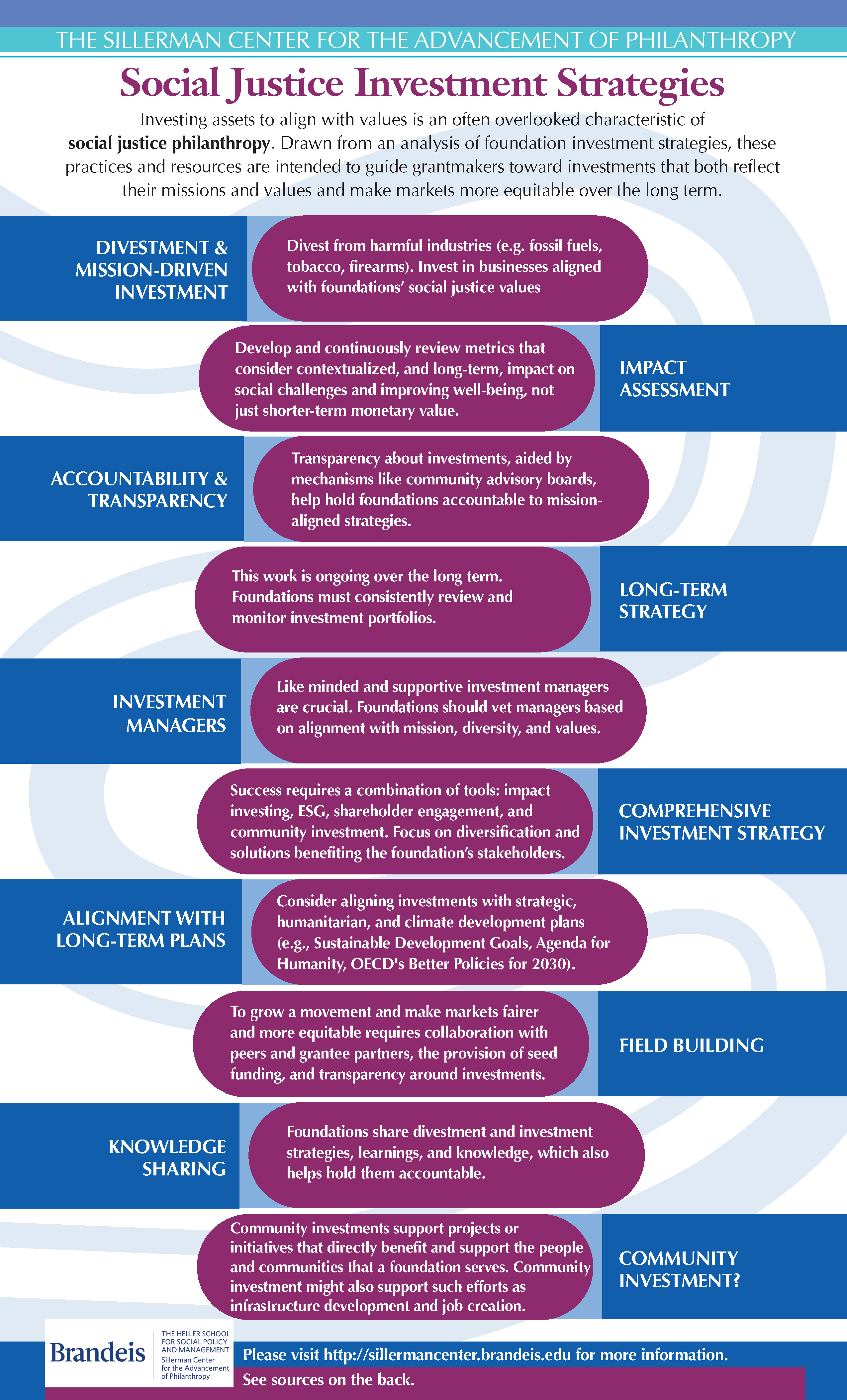Social Justice Philanthropy (SJP) is an ever evolving field. As social problems propel us to an uncertain future, we are compelled to uncover and share potential ways of collectively doing better. In the above video, you'll hear from Brian Stanley and Sheryl Seller, staff members at the Sillerman Center, as they describe their research and findings on Social Justice Philanthropy.
You can find an annotated transcript of this presentation, which includes numerous resources, here.
As is described in the presentation, in the following five sections you can further explore: 1) Background information about Sillerman’s SJP project; 2) Six common principles of SJP; 3) Seven pillars and practices of SJP; 4) Our Social Justice Funder Spotlight Series; 5) An infographic on Investment Strategy for SJP. The six principles aim to uplift the fact that there is no singular definition of SJP. The seven pillars demonstrate commonalities that social justice funders practice. We hope that these varied practices will provide an outline for and encourage more funders to participate in social justice philanthropy. The Spotlight Series provides case examples of social justice funders who operationalize SJP every day. Finally, the infographic offers ideas and strategies for funders looking to invest in a justice-oriented, mission-aligned way.
Background
From 2022-2023, The Sillerman Center conducted research into what Social Justice Philanthropy (SJP) claims to entail. We dug down into what SJP stands for, and what common principles and practices exist within SJP.
We found that SJP focuses on community - community building, community support, community-centered approaches, community organizing, etc. Community typically refers to those that foundations seek to serve and those who are impacted by grantmaking. For some foundations, community may also be referring to a place-based definition of community or to an identity-based definition of community.
Our research and analysis consisted of interviews with six foundations and a review of documents and language used by an additional twelve foundations.The research brought forth key words and ideas on which social justice funders focus: people, justice, movements, power, change, partnership, and organizing.
As one of the SJP pillars highlights, grantmakers are people-run institutions, and we know that justice-oriented funding is not a monolith. We offer these branches in support of those entities seeking social justice-oriented funding models and practices, and hope that continued research / work in this field leads to a more robust, ethical, and justice-centered philanthropic community.
Six Principles of Social Justice Philanthropy
- Social justice philanthropy focuses on systemic change that addresses historical injustices and root causes of racial, economic, and environmental inequities.
- Social justice philanthropy nurtures authentic relationships, relationship building, and support for organizers and advocates trying to repair unjust systems, laws, policies, and practices. Through building these relationships, we can work toward dismantling the top-down power over the legacy of philanthropy.
- Social justice philanthropy involves and includes the people affected by a social problem by centering them as sources of expertise and as key decision-makers and respecting their self-determination by giving with no strings attached.
- Social justice philanthropy strives to make grantmaking accessible, transparent, accountable, and responsive rather than burdensome and opaque.
- Social justice philanthropy donors and foundations act in solidarity with social justice movements and work to make the philanthropic sector itself more racially, ethnically, and culturally diverse, accessible, inclusive, and equitable.
- Social justice philanthropy invests its assets in socially responsible ways that do not contribute to the injustices that grantmaking is trying to remedy. Further, foundations use their assets and investments, alongside grants, to support progressive social change.
Seven Pillars and Practices of Social Justice Philanthropy
- Grantmakers as Entities: Grantmaking organizations are made up of people with feelings, thoughts, and motivations that shape intentions, practices, and goals. People who work within a foundation setting should examine their own feelings, humility, and understanding of personal and organizational positionality. Knowing that change takes time, the acceptance of discomfort will be essential for justice and equity-oriented programming and policies.
- Reactionary, Responsive, Persistence: Philanthropic work in practice is responsive, and sometimes reactionary. Conversely, it can also be long-term and focused on root causes of injustice. Grantmaking is “always work” and funders should fund and support grantees, partners, ideals, and movements for the long term. Funders must be willing to shoulder more risk, including lower and slower return on investment and providing additional support when grantees face challenges.
- Internal and External Policies: Foundations should have unified internal and external policies that uphold and are grounded in justice, equity, and the needs of those the foundation aims to serve. Foundations should value giving and receiving feedback and foster / steward relationships with grantee partners and those working to create and sustain social change. Similarly, in order to help shape funding priorities and solutions, foundations should make it a policy to educate staff and board members on the problems they are seeking to ameliorate.
- Intersectional Identities, Cross-Sector Issues, Ecosystem Approach: An intersectional lens asserts that individuals hold many identities and experiences at the same time, which creates complex, overlapping challenges and oppressions. Foundations should consider the multiple causes and sources of problems as well as the myriad solutions that exist in domains other than the one in which they are funding in order to support transformative change.
- Trust-Based Practices: Meaningful partnerships with communities and organizations are essential for a transparent, people-centered approach. Foundations must trust that community members have actionable, well-informed ideas about community needs and challenges. Practices should involve seeking regular feedback, sharing organizational practices, and collaborating with other funders. Funders should look to: simplify processes, provide multi-year / unrestricted funding, be responsive, engage community input, and offer support beyond grants to drive social change and promote philanthropic efforts.
- Participatory Practices and Shifting and Sharing Power: Participatory approaches help address and challenge traditional funder-grantee power dynamics in order to build individual and collective power that centers community voices, priorities, and decision-making. When it comes to participatory practice and power-showering, foundations can include specific identity or geographic groups, grassroots organizers and community leaders, or those united by a sense of belonging and shared identity in participatory practices, such as proposal review or decision making committees.
- Grassroots Organizing, Policy, and Advocacy Work: Where appropriate, funders should actively engage in federal, state, and local policy setting. Foundations should consider funding grassroots organizing and movement building that aims to fight for social, political, and economic justice and by taking stands on public policy. Foundations should consider convening federal, state, and local stakeholders to provide education and training sessions for foundation staff and board members as well as grantee partners.
Social Justice Funder Spotlights
Social Justice Funders Spotlights present stories of innovative, effective social justice philanthropy in action. Each spotlight focuses upon a grantmaker and a grantee. The spotlights explore various practices and models of social justice philanthropy. Check out our introductory video to learn more about the spotlights!
Link to Social Justice Funder Spotlight Homepage:
https://heller.brandeis.edu/sillerman/publications/spotlights.html
Links to each individual spotlight page:
Astraea
CJSF
DRF
Headwaters
Hyams
Unbound
Investment Strategy for Social Justice Philanthropy
Investment strategy is a vital and often overlooked facet within the realm of social justice philanthropy. In this context, investments should not only align with foundation missions and values but also contribute to making markets more equitable over the long term. The upcoming sections include an infographic that elucidates key investment strategy practices, accompanied by three (forthcoming) illuminating case examples that will showcase how foundations can seamlessly integrate these practices into their transformative work. This critical interplay between social justice philanthropy and investment strategy is a focal point of our exploration, featuring a comprehensive view drawn from a wealth of resources.
For this research, we reflect on a 2015 report highlighting a stark discrepancy: while 86% of foundation CEOs emphasized the importance of achieving financial returns, only 36% prioritized philanthropic goals. The subsequent resources and documents explored unveil diverse strategies employed by foundations, demonstrating a promising trajectory for social justice philanthropy and investment strategy convergence. From divestment principles to investments in mission-driven enterprises, our analysis delves into ongoing, long-term approaches that necessitate continuous review and methodology development to gauge impact.
Investment Strategy for Social Justice Philanthropy: Executive Summary and Terminology Guide
Catalyzing Change: The Chicago Community Trust’s Strategic Evolution in Impact Investing
Surdna Foundation’s Journey: Navigating the Evolution of Impact Investing
Investment Strategy Infographic


